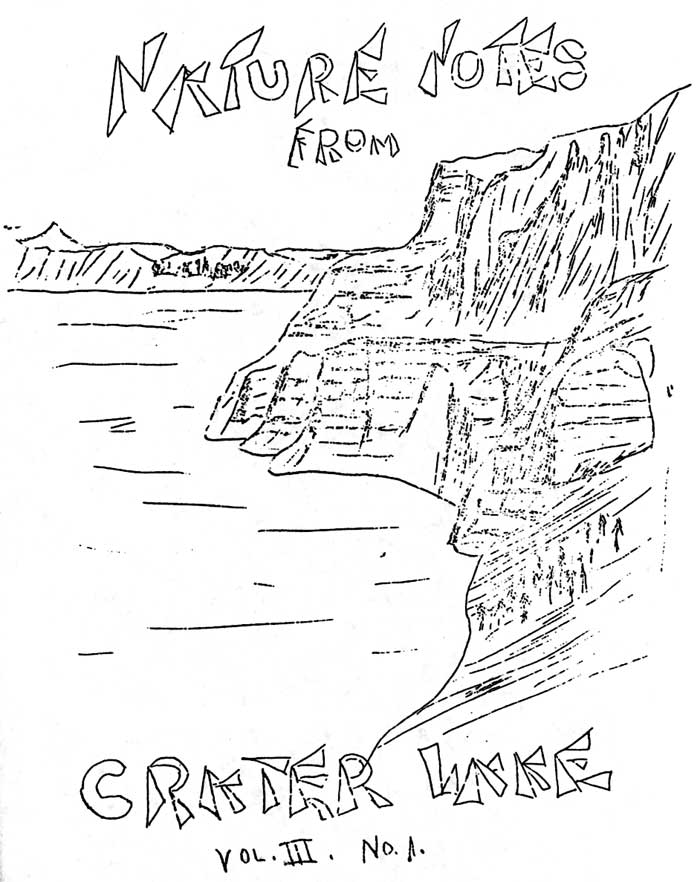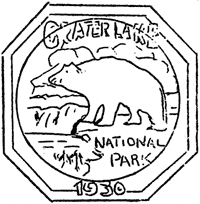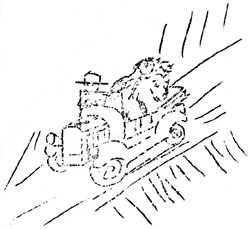Volume 3 No. 1 – July 1, 1930
All material courtesy of the National Park Service.These publications can also be found at http://npshistory.com/
Nature Notes is produced by the National Park Service. © 1930.
Greetings From Crater Lake National Park: 1930
By Earl U. Homuth, Acting Park Naturalist
“Climb the mountains and get their good tidings. Nature’s peace will flow into you as the sunshine flows into trees. The winds will blow their strength into you, and the storms their energy, and cares will drop from you like autumn leaves.”
Quotation from John Muir.
To our many friends scattered throughout the land, to those whose good fortune it has been to visit Crater Lake National Park, and to those whose pleasure still lies in anticipation, we extend greetings.
The season gives every indication of success. A light, late-season snowfall was soon cleared, and the camp grounds were bright with the campfire of visitors long before the official opening date, July 1.
The staff of the Educational Division has been again augmented and we wish to introduce Mr. F. Lyle Wynd, who has, during five years study in the Park, completed a “Flora of the Park”, soon to go to press; Mr. Norman Ashcraft for five years a ranger in the park; and Mr. Clyde Gilbert, a student of Geology, from Eugene, Oregon.
Triplets
By F. Lyle Wynd, Ranger Naturalist
Regularity and efficiency in the Administration of Crater Lake National Park is having far reaching results.
At one time the bears were so few in the Park that it was feared that Bruin’s portrait on the windshield stickers would soon fail to have any significance. It was in the Spring of 1919 that the bear situation took on a new aspect.
At this time, a long, starved-looking she-bear put in her appearance. There were other bears to be sure, but a strange coincidence of fate was to make this unpromising looking lady the forerunner of all the bears now commonly seen about Park Headquarters.
Her first season in the Park she brought in two cubs, Jim Jeffries and Jack Johnson. Owing to a slight error on the part of those doing the christening, Jim Jeffries later had her name changed to Jemima. By popular consent Jack Johnson became Buster.
Maggie, for this was the lady’s name, was to have a short career. In 1920, scarcely a year from the time she had placed her confidence in human beings, she wandered to a logging camp some distance from the Park boundaries. Trusting that all the world was like Crater Lake, she sat down before a tent and waited to be fed. In an instant it was over. The inhabitant, being a true sportsman, shot her dead. It is probable that even now certain gentlemen are telling heroic tales before an open fireplace with their stocking feet comfortably buried in a soft bear rug.
But all was not lost, for Maggie had already done her bit for Crater Lake.
In the best of families there are things better left unsaid, but for the sake of scientific accuracy, it must be related that Maggie’s son, Buster, came to a bad end. He grew to an enormous and beautiful brown bear, but his temper was cross and uncertain. As he grew older, he became fatter and crosser. He was finally executed as a measure of public safety.
But with Jemima, Buster’s sister and Maggie’s daughter, things went differently. She also grew large and beautiful, but her temper as vastly different from her big brother. She became very tame and gentle and for many season she has been a constant source of amusement and wonder to the visitors at Crater Lake. She was very often to be seen curled up on the back porch of the cook house at Park Headquarters snoozing blissfully, awaking occasionally to receive tid-bits from the cook.
In 1921 Jemima came to camp with two cubs. They were promptly named Hans and Fritz. In alternate seasons with clock-like regularity Jemima, or Jimmy as she is now called, brings a pair of furry youngsters to Park Headquarters for christening.
Fritz, one of Jemima’s first cubs, was true to his masculine instinct, and soon wandered away to a new stomping ground. He has not been seen since.
His twin sister, Hans, followed the footsteps of her mother. She remained at Crater Lake, and became extremely tame and gentle. She was photographed and fed, and petted until finally, one thing leading to another, she became nationally famous. At the tender but robust age of two years the qualities of her genius were broadcast over Radio Station K. G. O. One newspaper after another published articles and pictures of her, but all this made no difference to her. She had already determined that her career was to populate Crater Lake National Park with bears.
Her first children came in 1926. Realizing the importance of her position, she had triplets. She trusted all humans insofar as she herself was concerned, but she did not trust their baleful influence on her cubs. Only in the later part of the season when they were of good size, and able to take care of themselves did she bring them into headquarters.
Again in 1928, Hans presented the Park with triplets. One of these has evidently disappeared.
In the spring of 1930, it was a subject of much discussion among the rangers and other employees of the park as to the probable showing Hans would make this season.
In the later part of May there was great excitement at Park Headquarters. Just at dusk someone shouted, “Hans, Hans!!” In a moment the entire government force, from the superintendent to the bull cook were screaming about, “Where, Where?”
“Behind the blacksmith shop!”
Sure enough there was Hans, a little the worse for the winter’s duties, but the cubs — where were they? Where else, but up a tree.
The cook hurriedly obtained a bucket of meat scraps for the mother, and with the craning of many necks, three furry, black balls were finally dimly descried through the gathering dusk in the very tops of those different mountain hemlock trees. At last Hans had discovered that National Park humans were different from many others. She now trusted them enough to bring her tiny babies almost as soon as they could walk.
The dusk became black night, and still the entire population of Crater Lake stood knee deep in snow with clattering limbs, peering at the now partly visible youngsters. They were whimpering softly to each other in the tree tops, when the admiring crowd dispersed. Judging from the exclamations of the mother and quantities of affectionate baby talk lavished on the youngsters, there will be a happy family of bruins at Crater Lake this season.
Hans is probably the only wild bear known that will willfully climb on the side of a car, and wait to be taken for a ride about the camp ground. By careful work and many soft words she has been enticed into a closed car and taken for a ride. She sits in the seat rather awkwardly to be sure, but she is well behaved, and watches the passing landscape with such an extreme interest as to be almost comical.
Hans is beyond all question the best known, and best loved bear that ever gave her confidence to people of Crater Lake Park.
While those familiar with the habits and individual tempers of wild bears may do many wonderful things with them, it should be not inferred that they are as gentle and harmless as domestic animals. It is always dangerous for tourists to attempt even to feed the bears.





